Automotive Artist Andrew Kitson first had a taste of racing at Brands Hatch at the early age of only six months old. His passion for motorsport has been with him ever since. It's in his blood.
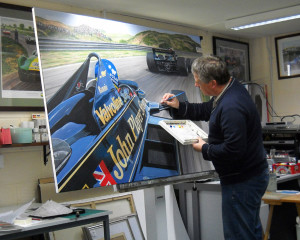
'Wingman' Ronnie Peterson follows Mario Andretti at Zandvoort, a Lotus 1-2 for the beautiful Lotus 79 in the Dutch GP in 1978 by Andrew Kitson
I really like the tribute you made to your father on your website sharing the story about what he has done with the photos. Does your father share your passion for cars?
I was born in Cambridge which is not far from Silverstone or Snetterton and as early as I can remember, my father was into racing cars. My parents told me that the first race meeting they took me to was at Brands Hatch on Boxing Day 1959 when I was six months old. I was tucked up in my carry cot in the car. I just feel annoyed that I wasn't old enough to appreciate it. I've always been around motor car racing. My father was a great enthusiast and a very great fan of Archie Scott Brown. He would often go to Snetterton to watch him race. The company he was working for used to make farming machinery and the guy who owned the company was an amateur racer himself and he had some cars. My father was good at looking after his motorbikes and cars and so was asked if he would prepare his bosses cars for racing and be the mechanic at the races. My father being the great enthusiast agreed and so every weekend we would go off somewhere. It was amateur racing and a weekend thing. So from a very early age I was on the stop watch and cleaning and polishing the cars, sticking the numbers on and was generally helping out wherever I could. It was a passion I had for motorsport and it's been with me all my life.
But you did not follow in your fathers' footstep and become a mechanic?
No. When I was at school, I was always in trouble with the school teachers for drawing racing cars in my school books. Even in the art classes, I was forever in trouble for drawing racing cars, rather than painting pictures of trees for example or the task we had to do.
Did your father encourage you.
Not really. It's just something which I used to enjoy myself and as far as I know, there's no-one else in my family before me who was an artist. What I really wanted to be was a racing car designer and so I used to sketch out ideas for racing cars and space frames, that sort of thing. Unfortunately I wasn't very good at physics or mathematics at school, which you need for that. But I was very good at drawing. So after school, I went to train as a technical illustrator and did exploded drawings and cutaways etc. It was a mix of engineering and trying to understand the engineering draftsman drawings and making illustrations. I spent quite a few years working in the German car industry when I first started work. That was two weeks working flat out and then two weeks off. I was taught how to draw properly at college and observe. It was all line work, mainly black ink pen illustrations which were used for information and instruction manuals. In the two weeks I had off, I would come home to the UK and start doing my paintings. In the 1960's Michael Turner and Dexter Brown were the big artists back then and as a boy, I was always a great fan and especially loved Michael Turners' work. So whenever I had time off from my work in Germany, I would use the skills I had learned as an illustrator and come home and paint. Looking back, my first paintings were far too detailed....and some terrible!
As far as colour goes, I am completely self taught.
Going back to when I was at college, training to be a technical illustrator, I used to go home at weekends and I would work at Royale Racing for the Formula Ford team when Rory Byrne was the designer there in 1977. Of course he went on to Ferrari later and designed Schumacher's cars. Pat Symonds was there after him and he is now at Williams F1 but I got to know them there. They were designing the Formula Ford cars at the time in the mid-70s. So at the weekends, I was just helping out in the workshop and helping at the race meetings.
So you were getting pretty close to designing race cars?
I wasn't really designing. I wasn't using any artwork skills at Royale, I was just helping out, like I used to with my father. Kenny Acheson won the three Formula Ford championships in the UK in 1978 for Royale Racing, when I was there. So it was great fun really being at the race circuits every weekend, and during the week I was off doing my technical illustrations at college. So I have always been a great enthusiast and still am.
And it helped that you created such a wonderful network in that scene
Absolutely right and that's where I think in a way, I am slightly unique as far as other artists go. A lot of other artists will go and hold exhibitions etc. and sell their paintings to the general public, whereas throughout my whole career, I have targeted people that I have met in the sport or people who own cars, race cars, sponsors or circuits, that sort of thing. I have done very few paintings really for fans and enthusiasts. Most of my work has been for people with racing cars and people who race them. I've done posters and award paintings for sponsors which they have given out at the end of the year. Another thing I do are the montage type pictures, which go down very well with drivers who like to have a painting to show their cars and career in one painting. The problem a lot of us have is wall space. You only have so much in your house, so if you are a driver who has driven lots of cars for many years, you don't have enough wall space to show a photo of every car but you can have one nice big painting that shows them all.
So the majority of what you do is commission work?
I would say all of it. I never have any for sale because they are all commissioned. I am very proud of the list of people who have commissioned my work and also people who have been presented with my work. Some people who have commissioned paintings have presented them to others, for example the British Touring Car Championship. BTCC chief Alan Gow asked me to do a painting of their champion Giovanardi in his Vauxhall in 2007, an extra award to go with his trophy.
I also saw some work you did of Ayrton Senna. You have a wonderful line up.
Well I wanted to do a limited edition print of Ayrton Senna with his signature. So I thought the race in Brazil in 1991 would be a good subject to do. I did the painting and called it 'Home Town Hero' and an American company who I worked with to publish my work, produced the prints. I took the prints and the painting to Silverstone. Bernie Ecclestone has always been very kind to me and has given me passes for paddock access on many occasions. So I went to see Ayrton and showed him the painting and he thought it was fantastic. We reached a deal with him to sign the prints, he signed them right there and then. He said he really loved the painting and was going to take it home with him and put it in his apartment in Monaco, which he did. I have heard that the painting has been in the offices of the Ayrton Senna Foundation in Sao Paulo since his death in 1994. I can say that Ayrton Senna was one of my clients and he always had time for a friendly chat whenever I saw him after our deal.
From Lewis Hamilton, to Alain Prost, Nigel Mansell, Nelson Piquet, Jackie Stewart, Ferrari, Honda..so many people have got my paintings.
Even Bernie Ecclestone has one because a long time ago, I did a painting for a client of Nigel Mansell in a Ferrari. But the guy who commissioned it couldn't pay for it. So I was left with this painting and was thinking about putting it up for sale, however because Bernie had been so kind to me, I thought I would send it to him. I had a lovely letter back from him saying it's great and I'm going to put it in my office. If he ever did, I don't know. I've never seen his office!
It's helped oil the wheels with passes etc, so to speak. Little things like this always help.
But does doing all those commissions limit you in your artistic freedom?
That is a good question. Not always because the clients I like working for most are the ones who just leave it to me. I tell my clients that I work best when I am left alone to be creative. Some clients give a rough idea of what they want and I always send a sketch first to show what I propose to do. Generally I am happy with what I do and the way I am doing it, keeping the client happy with content they want but also putting some of myself in it. It's about striking a balance.
What do you want to express when you do a painting. Do you always try to capture certain crucial elements?
I like it to be fairly accurate to what actually happened. Sometimes when you are doing something really old from the 1950's or 60's, there isn't the t.v. broadcast to look at or reports in magazines and only a few photographs available. That gives you great scope for artistic licence because no-one can tell you that you are wrong! So I like to try and get it as accurate as possible either from the reference material available, my own knowledge of the past, or from using my imagination to a certain extent. I also like to try and show the speed and a bit of drama in my pictures but also for people to look at it and feel passionate. Us race fans are very passionate about the sport and I want to try and bring out that passion in people.
There is a lot of detail in your artwork.
There is one which I did of Jimmy Clark winning the 1965 Indy 500 in the Lotus 38. I did that painting in 2010 and worked on it with Clive Chapman at Classic Team Lotus. I painted it with the purpose of making it a limited edition print but there was also a charity auction coming up for a children's hospice. I thought it would be really nice to auction the painting off for that charity. So I told Clive Chapman about it, who is a friend and lives very close to me, and the actual car was at the Classic Team Lotus workshops being restored. Clive gave me access to the car which was fantastic and I managed to take lots of photographs and did a few sketches here and there. But using the photographs I took, I chose a unique viewpoint from the car which you could never take as a photographer at the track, or you would be run over. It's as if you are standing right on the white line at Indianapolis on turn 3. Clive was quite particular about certain details on the car and I am pretty confident it is very accurate. A lot of artists have painted the car before and some details on some pictures are a bit vague. From the photographs I took of the car in the workshop, I added the driver and crash helmet, changed the angle of the suspension slightly to show that the body roll on the track, and added all the background and everything around it. I put the other cars in the background with a little bit of oversteer to give a bit of drama. I am very pleased with that painting. It was quite a big about 1.70 meters wide.
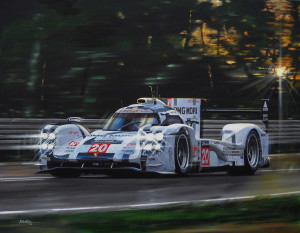
Painting of Mark Webber in Porsche 919 at Le Mans 2014 by Andrew Kitson which he donated to sick children.
Do you usually use the large sizes?
It varies. It can be very small from something like 30 cm across to the largest I did about ten years ago, which was a mural for JD Classics at 17 metres long. They wanted the wall filled up with a painting and I suggested doing it on wooden panels. So it's all done on panels which were then screwed to the wall because I thought if you ever want to move the business, you can take it with you. That was a long challenging project.
So do you have the space in your studio to do those large paintings?
My studio now yes. When I did that mural, I only had a tiny studio and could only do three panels at a time. It consisted of 15 panels altogether. So I used to work on the left hand panel and the centre one, and once I had those two finished, I would move the left hand one out the way and then put another one at the end. Like a conveyor belt. An artist has to stand back from his work and the way I got around this was to look at my work through the wrong end of my binoculars on a step ladder!
The Super Nova Mural on your website is so different from anything else you have done.
Well David Sears took over the old premises which were Argo racing cars and in the reception area, there was just this engineering drawing of an old Argo racing car on the wall. He wanted something 'abstract' in its place but didn't know what. He asked me to come up with something which was engineering like but also a little bit abstract. So I thought showing the wind tunnel type of effect, his team was in F3000 at the time and moved into GP2. So I did an F3000 car and just used some very abstract colours because I wanted it to stand the test of time. I didn't want it to be specifically one colour which might not suit future sponsors. If he got a future sponsor and the cars were all bright yellow and I had done it in bright red, it might be in conflict. So I tried to keep it fairly neutral.
I find it intriguing that you did this style so abstract compared to your other work
Well I'm fairly certain I could turn my hand to anything but the style you see in most of my paintings, is the style I have grown into and it's what my clients seem to like. I've often thought I would like to go off and do a different style but it's just down to having the time to do that. Maybe one day but for now, this is what I do and it gives me a great deal of fun. I know I am very fortunate because all my life I have been a great fan of car racing and very lucky to make my living doing something I love. What can be better than looking at photographs of racing cars all day for reference! So I do appreciate how fortunate I am.
What kind of advice would you give to people wanting to become an automotive artist?
Hard work. Dedication. Every hour you can spare, try to do something. They have to be passionate about what they are doing. First of all pick subjects or cars you really like and think are beautiful. Then you will make a better job of it. I have given talks to young school children about being an artist, not necessarily an automotive artist. So many school teachers have the children drawing a bowl of fruit or still life, but kids aren't interested in that. I tell kids to draw their favourite football player or their pet or something like that. So I would always say to young artists, first of all draw what you are passionate about. Expect it to be hard work, you will get criticism but you have to learn from that. Grow a thick skin because people do sometimes like to tell you if they don't like something. You just have to take it on the chin and try to learn from what they say and just enjoy what you do. That's the most important thing. It's a great buzz to finish a job and be proud of it and think wow, I did that. It's a great feeling.
Do you have a bucket list of artworks that you want to make one day.
I have thought about this a few times. Yes, I would really love to paint more of the older stuff. The pre-war things. When I was growing up in the 60's, there were so many great club racing cars here in the UK and I would like to paint some of those, just for myself, which I am sure have never ever been painted. There was a favourite single seater in the 60s called the Kincraft, I would love to paint that if I had time. But I would also like to venture out and do some more aircraft, seascapes and landscapes. It's just having the time. People sometimes ask me when I am going to retire but as far as I am concerned, I'm going to keep going until I drop. When people retire, some take up painting...I just started early! There are certain cars I would like to paint more of, like the Maserati 250F and more of the 60's cars but I really have to rely on commissions and what people want.
Many artists in the automotive scene struggle with the fact that their art is not seen as fine art but as a separate segment which doesn't belong in a museum etc. What is your philosophy on that?
That is exactly right. That is how it is seen. They don't view automotive art as fine art. The same with people who paint aircraft. The background in a lot of aviation paintings, especially the ones which show aircraft flying over a valley or taking off where you see a landscape, are wonderful as a landscape painting. It's just that it has an aeroplane in it. It's very much the same with automotive art. It's not seen as fine art and I really do not know why it should be like that. Maybe one day when the automobile is 200 years old, they may look back and think 'hey hang on, this is an important part of history' and it might then be accepted.
I see it as my mission to convince the art world that they are missing something. I like the passion I find in all the artists and I believe that quite a few of them are making fine art and should be respected by the fine art world and be positioned as such.
I applaud you for that. I am also greatly influenced by artists like John Constable and all the detail he used to put in his pictures and Canaletto's work from Venice. Astonishing landscape work. That is fine art. The only difference we have is we show the speed and drama of the sport. Are there any sporting pictures at all which are considered as fine art, maybe hunting pictures with horses?
Cars are now over 100 years old and we might be getting to an era of electric cars. It's only when we close an era or move towards another culture, that people look back and remember.
That's exactly right Marcel and you can see that with people who did the steam locomotives, the railway paintings. They are very collectable now because you rarely see these locomotives anymore. It's all moved to these boring electric trains we have. I can see your point and I think that could be right. It's all part of history and it should be fine art. Especially when you look back at some of the paintings which artists have done of pre-war cars like Bentleys and Bugatti's etc. It's all part of history.
There was a guy called Norman Rockwell in the US and he was doing illustrations for the newspaper every week depicting the day to day life in New York. He was not well respected during his life but after his death, people realized that he captured the culture of that time and it's now highly valued by the art industry. I think one of the roles of an artist is to capture the passion and emotion of a culture of a certain moment. So what you are doing with your club racing is important.
It IS important and as an artist, it's my passion as well and keeps me interested in what I am doing. You were just saying about that chap in New York and when you look at Crosby's work, it was the record of the first days of motor sport. From the times when people were riding a horse, people were racing each other. So it's just human competition and the fact that we are using a vehicle for it. So what?
To see more of Andrew's work, visit Andrew Kitson Website.

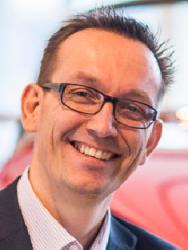

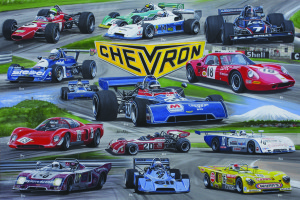
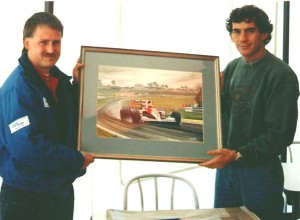
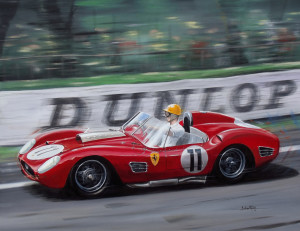
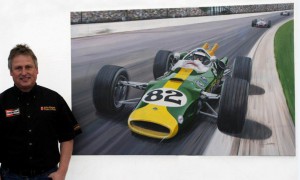

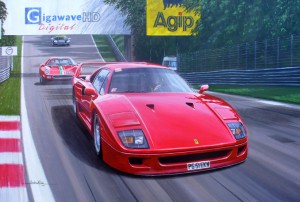
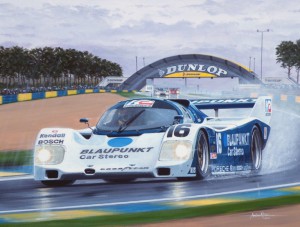
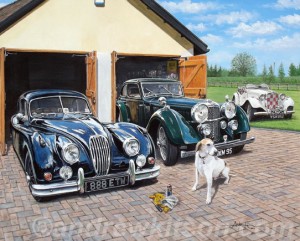
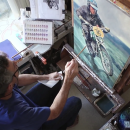
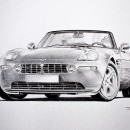
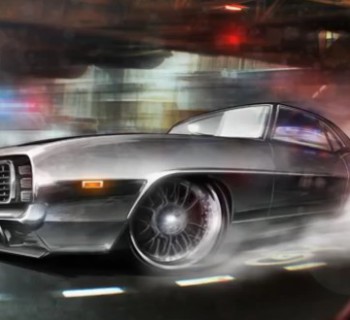
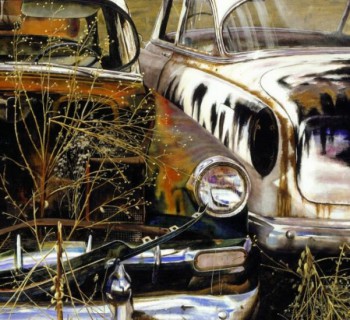
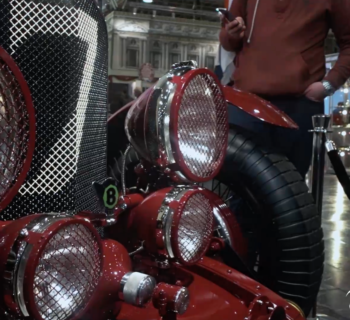
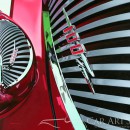
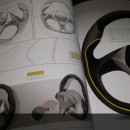
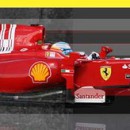


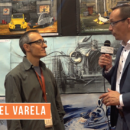
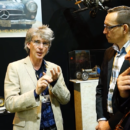
[…] Want to learn more about Andrew Kitson? Read the interview CarArtSpot did with him http://www.carartspot.com/car-art/artists/car-art-blog/andrew-kitsons-first-f1-race.html. […]